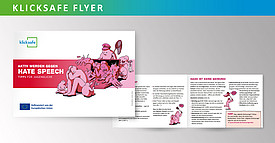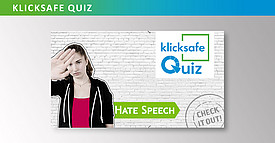Hate Speech
Incitement, hatred and discrimination in social networks, online forums and comment columns have become a problem for society as a whole. They threaten diversity of opinion and democracy. Forsa surveys commissioned by the Media Authority NRW show that the vast majority of Internet users surveyed are aware of hate comments on the Internet. In a nationwide, representative study commissioned by Campact e.V., almost ¾ of respondents said: they are concerned that verbal violence on the Internet is increasing violence in everyday life.
Hate speech is not purely an online phenomenon, but is based on analog power and discrimination structures. In addition, a kind of disinhibition effect can be observed on the Internet. Opinions that are often only openly held by a minority in real life are published with just a few clicks and find a large stage on the Internet. Behind this are not infrequently right-wing extremist groups and individuals who use the possibilities of the Internet for their propaganda. The lack of a direct counterpart, the possibility of remaining anonymous, and the knowledge that they will hardly be held accountable further contribute to disinhibition. Not only is hate speech anonymous, but it is also often carried out openly using real names.
Hate speech does not affect everyone equally. While cyberbullying, so-called shitstorms or a crude communication culture on the Internet can, in principle, affect everyone to the same extent, hate speech is primarily directed against people because they are assigned to a certain group. They experience devaluation on the basis of their skin color, their (supposed) origin, their religion, their gender, their sexual orientation or their body. In this respect, hate speech is closely linked to the concept of group-based misanthropy. However, it can also affect those who are not themselves assigned to one of the aforementioned groups, but who stand up for their rights and against misanthropy online and offline.
Forms of Hate Speech
Hate speech can be expressed very directly, for example in clearly racist or sexist insults and by inciting violence. Sometimes, however, expressions are more difficult to assess. How can you recognize hate speech even in its more subtle varieties? Using various forms of hate speech as examples, we present central linguistic and content-related patterns.
In the context of the global refugee crisis and the associated debate about immigration to Germany, racist hate speech has gained massive intensity online. The Internet acts like a megaphone here: the real number of haters may be relatively small, but their permanent visibility gives the appearance of a broader movement. This in turn can boost racist acts and right-wing extremist groups in analog life.
This is also possible indirectly - for example, through the dissemination of uninformed or false statements that serve racist stereotypes, such as those about "social parasites." Racist statements often disguise themselves as humor or irony.
One of the recurring motives of racist hate speech is to instrumentalize debates about sexualized violence against women. The demand to protect "our women" from "them" is an example of the "us/them" rhetoric typical of hate speech. Incomplete information, disinformation or rumors about crimes and one-sided or subjectively filtered reporting in one's own filter bubble condense into a conspiracy-theory worldview. Media that report differently and in a differentiated manner are degraded to the status of "lying press.
In addition to these more indirect forms, hate speech is expressed in direct form in calls for concrete acts of violence against refugees or people with a migration history. In both forms - direct and indirect - hate speech contributes to a social climate that gives racist and right-wing extremist individuals and groups the feeling that they are acting in the interests and as the mouthpiece of a silent majority. One measure of this mood is the current figures from the Federal Criminal Police Office, which count an increase in politically motivated acts of violence with a right-wing extremist background.
Closely related to racism in general is hate speech that attacks and devalues people on the basis of their religion. Anti-Semitic and anti-Muslim voices are particularly noticeable here. The phenomena differ from one another in history and content and should not be equated here. What they have in common, however, is that they use religion or culture as a pretext to devalue people - regardless of actual religiosity and religious practice. The limits of legitimate criticism of religion are far exceeded in both cases.
Anti-Semitism remains widespread in German society. Anti-Muslim attitudes have increased sharply in recent years - and demonstrably not only on the right-wing fringe or in right-wing extremist scenes, but in all social strata. This sentiment is picked up and amplified on the Internet. Entire blogs are dedicated to inciting hatred against people of the Muslim faith or defaming associations and mosque communities as well as politicians who do not act in a religious capacity, such as Cem Özdemir or Aydan Özoguz.
The social networks and comment columns of online media are full of age-old stereotypes of a threatening Islamization. They draw heavily on particularly striking imagery - also typical of the hate speech phenomenon. Young people can also be directly affected by this type of hate speech. If it goes unchallenged, it often creates a feeling among young people that they are excluded, rejected and not respected because of their religious affiliation or family background.
Sexism refers to the discrimination and devaluation of women and girls on the basis of their gender. Women in Germany experience this in the form of sexual harassment in public, at work and school, or in their social environment - many as early as adolescence.
The Internet is no exception. Young female users in particular often experience sexist attacks there. These include degrading slogans and sexually explicit insults, the threat or advocacy of sexualized violence, and even the publication of real or digitally manipulated nude photos. Often the threats occur in such a concentrated form that it can be assumed that the perpetrators have formed a kind of "hate group. Women who express themselves politically as politicians, bloggers, activists or journalists are often affected. They experience a different kind of criticism than their male colleagues, are more often judged on the basis of their appearance or attacked in their sexual integrity. But girls and young women who use the Internet on a daily basis and rightly see it as their digital habitat can also become the target of sexist hate speech as soon as they express themselves publicly there.
Discrimination on the basis of gender identity or sexual orientation also affects transsexual, intersexual and homosexual persons or transgender people. Here, young people in the phase of finding their identity are particularly at risk of becoming victims of hostility, devaluation and collective violence. The transitions to cyberbullying are fluid (see "Hate speech and cyberbullying").
In the same way, indirect hate speech directed against these groups in general unsettles young people. It can deprive them of the self-esteem they need, especially in this phase, to deal with their bodies and sexuality in a self-determined way. Central elements of homophobic hate speech include conspiracy theories of state-enforced re-education, organized "advertising" for homosexuality and a powerful "homo lobby. Equating what cannot be equated - homosexuality is associated with pedosexual criminality, incest or bestiality - is also a central motif of homophobic hate speech.
The patterns of hate speech described can also affect those who are not themselves assigned to one of the groups mentioned, but who are active online and offline against misanthropy or who are active in civil society: Refugee helpers, feminist and anti-racist activists, or politicians. They themselves are often the target of hateful comments, insults and threats. But even young people who intervene in debates with a clear stance can be exposed to hostility.




